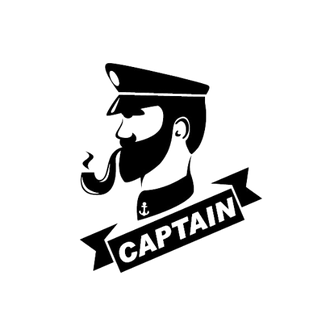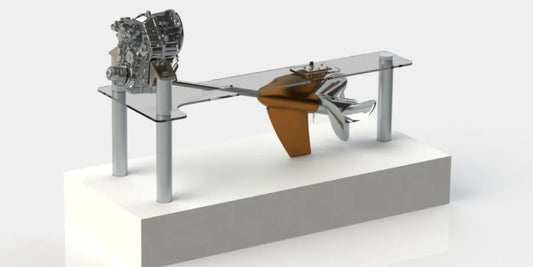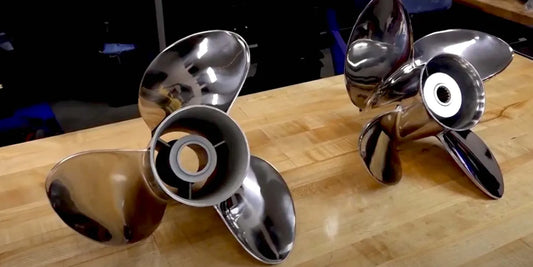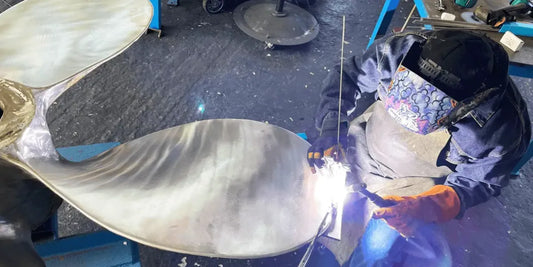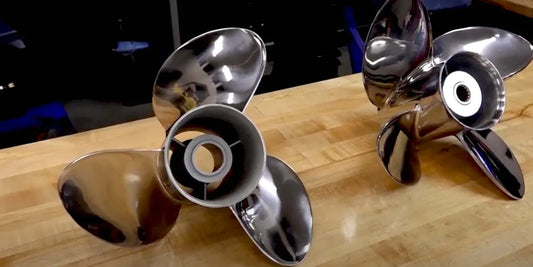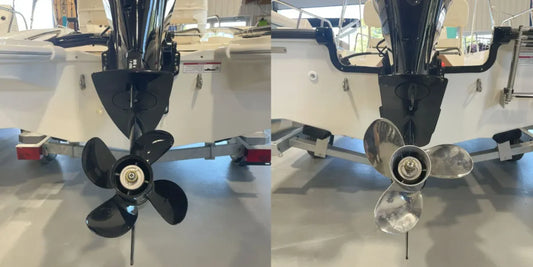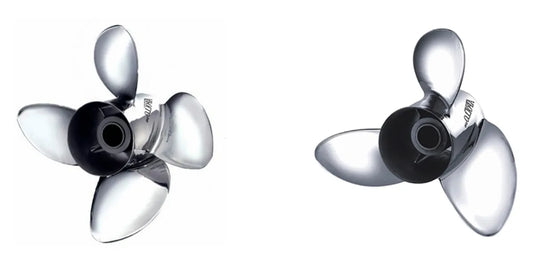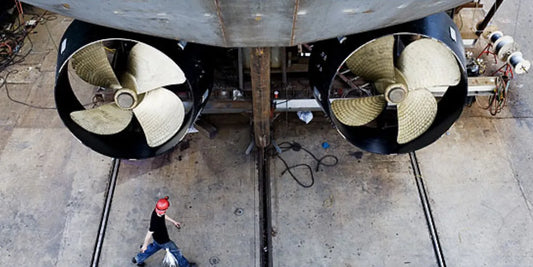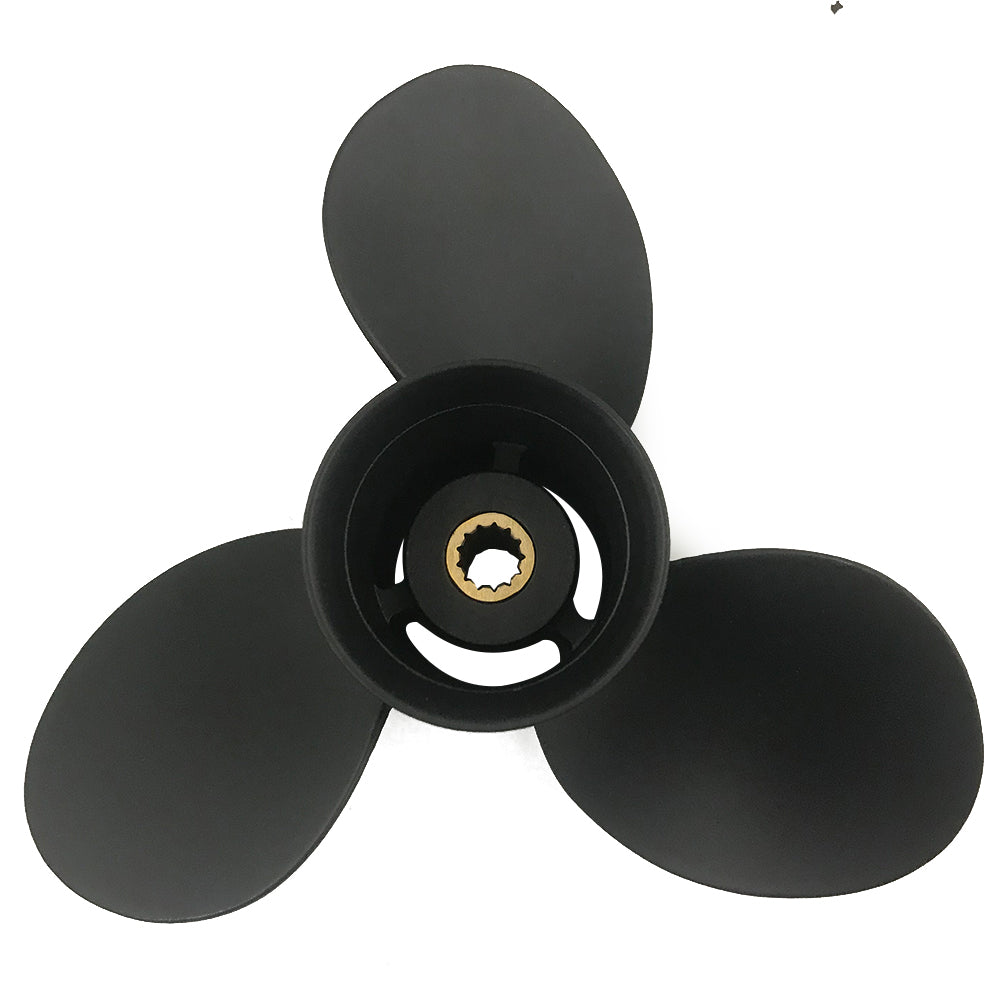When improving any aspect of your boat's performance, the propeller plays a vital role. Aluminum and stainless steel are the two most commonly used materials for making boat propellers, each with its advantages and meant for specific applications. But how do you honestly tell who the best candidate for your vessel is? The blog pits aluminum and stainless steel propellers against one another and articulates their primary differences in reliability, price, style of work, and general application. Whether you want the speed to go higher, the fuel efficiency to be better, or a handy, cheap replacement, this guide will surely equip you with the knowledge to choose wisely for your boating needs.
What Are the Key Differences Between Aluminum and Stainless Steel Propellers?

Understanding the Material Composition of Aluminum and Stainless Steel
Aluminum and stainless steel are two different materials, each bearing a distinct function profile to be used as a propeller material. Aluminum is a light, relatively cheap material, often consisting of an aluminum alloy mixed with trace amounts of magnesium, silicon, or copper to increase strength and resist corrosion. Its light density makes it easier to work with and adds less weight to the structure, a significant advantage for smaller boats or any other craft where fuel efficiency is paramount.
Stainless steel is an alloy of iron, chromium, and nickel that offers strength, wear resistance, and durability. The chromium content makes a passive oxide film on the surface that highly improves resistance to rust and corrosion, ensuring it lasts longer even under abrasive saltwater conditions.
Aluminum would be ideal, considering the trade-offs involved, if you want something economically priced for low—to moderate-speed applications. Stainless steel, on the other hand, being stronger and more expensive, will really provide the best function for high-speed or precision boating. Understanding the characteristics of both materials is the key to selecting the propeller for a specific need.
How Do Aluminum and Stainless Steel Props Affect Boat Performance?
When looking over how the different propeller materials affect boat performance, one must consider the primary factors: speed, fuel economy, and handling. Aluminum propellers weigh less, making them best suited for small- to medium-sized boats. Their reduced weight allows acceleration to be swift, and fuel consumption efficient at moderate speeds. They can also be repaired more quickly, making them a convenient and economical option for recreational boaters. On the downside, the soft composition of aluminum can wrap and damage the propeller when confronted with solid underwater obstacles or significant impacts.
On the other hand, stainless steel propellers are excellent for high-performance applications. The sheer durability and rigidity allow the best power conversion to a higher top speed and smooth handling at any RPM range. This makes stainless-steel props a good choice for high competition or precision boating. From a corrosion and wear standpoint, stainless steel means longer life than aluminum. These benefits come at a higher initial price and, perhaps, repair costs, which might motivate the more budget-conscious users to go the aluminum way.
Ultimately, choosing one over the other depends mainly on what the boat will be used for, the money available, and what the user expects to gain in good performance through the contract. Mutually agreed-upon variables will lead to evaluating those involving balance for optimum performance and value to the vessel.
Cost Considerations: Is Aluminum or Stainless Steel More Economical?
Aluminum versus stainless steel propellers entail evaluating both initial costs and long-term servicing expenses. These propellers tend to be more economical initially, making them popular among the occasional or recreational boaters with a limited budget. On the negative side, aluminum propellers are also cheaper to fix or replace when damaged, which can become a deciding factor for those operating in an area where the water level is shallow or underwater obstructions.
Stainless steel propellers, on the contrary, have a heftier price tag at the outset yet generally offer the best value regarding durability and performance. Stainless steel propellers resist damage, bending, and corrosion, reducing the frequency of replacements or repairs; therefore, in the long run, it gives better value. Its superb efficiency can also offer fuel savings, which will help pay off the upfront cost over time for users who boat on a regular frequency or take longer trips.
It comes down to weighing the up-front cost against the benefit over time. As suspected, aluminum will be the way to go, prioritizing short-term cost efficiency. However, users seeking reliability and performance in harsh conditions may find stainless steel a more highly valued investment while also weighing it down with that high upfront investment. Careful consideration of usage and budget priorities will steer the buyer toward the most cost-effective choice for his/her needs.
How Do Durability and Performance Compare?

The Impact of Durability on Propeller Longevity
Durability is the utmost consideration governing a propeller's life span and effective functioning under varying operating conditions. Stainless steel propellers are famous owing to unparalleled strength and wear resistance; indeed, they last longer than their aluminum counterparts. Being tough, stainless steel can take impact and resist deformation or cracking that would otherwise reduce its efficient use in harsh and high-speed environments. For example, marine tests have shown that stainless steel propellers can tolerate saline environment exposure for long periods, while resisting heavy torque loads with little or no erosion in their working ability.
On the contrary, aluminum propellers, while light in weight and economical, cannot withstand impact damage or stress over time. The development of cracks, dents, or corrosion, especially in harsh environments, ends their life sooner rather than later. Aluminum can do while one is operating in moderate areas. Yet, in rough waters or when encountering heavy debris, stainless steel is often chosen for its long-term durability, quite in contrast to its initial cost.
In the end, understanding the environmental requirements and the compromise of durability between aluminum and stainless steel will enable a more informed, cost-effective decision.
Performance Metrics: Top Speed, Flex, and Fuel Economy
Top Speed: In performance terms, top speed is an essential feature that directly describes the efficiency of the propeller and its compatibility with your boat. A stainless steel propeller would generally offer a higher top speed as it cannot flex too much against pressure; the least bit of flexing would mean energy loss in the transfer of energy from the engine to the water, and disconnecting with the design intent. Aluminum propellers, anyway, may slightly bend. Such bending and distortion reduce top speed to some extent. The engine's stress would also vary depending on the propeller's performance at top speed. It thus would be a preferred choice for anybody whose priorities lie in attaining their maximum velocity and consistent performance.
Flex: The characteristics of flexibility vary among the materials. Aluminum propellers are much more prone to flex at heavy loads or high speeds, and do lose efficiency slightly due to that energy loss, so-called energy dissipation occurs. A stainless steel, however, remains rigid, thus providing consistent thrust for a longer service life. The rigidity means there are few losses in the energy transmission, improving acceleration and top speed. Ultimately, a choice between rigidity and flexibility might be made based upon operational requirements and budget.
Fuel Economy: Fuel economy is another primary concern associated with propeller performance. The most efficient energy transfer means the least fuel use, whereas a stainless steel prop generally beats an aluminum prop. Its rugged construction leaves much of the power unexhausted, giving the best mileage and fuel economy in the long run. Aluminum can still do well enough in moderately demanding situations, but those pursuing more significant long-term savings and steady fuel economy invariably prefer stainless steel. Properly matching pitch, engine, and boat application for your operating condition best enhances fuel consumption, so pick the configuration that best fits your situation.
Which Material Offers Better Durability in Shallow Water?
Regarding shallow water running, durability is essential when selecting a propeller material. Steel propellers do considerably well due to their strength and general impact resistance. Stain steel is a robust material that allows propellers to absorb stress during impact with submerged debris like rocks or logs and resist bending or breakage. Also, the densest composition of stainless steel allows thinner blades to be designed for the propeller, compensating for the loss of thickness with better efficiency, without compromising the design's strength.
In contrast, aluminum propellers tend to be easily damaged in shallow waters. They are light and economical compared to stainless steel propellers, but they are softer, and when struck, they tend to get nicked, bent, or broken. Hence, they provide a much less confident choice for those who rely on regular use in areas where underwater obstructions are common. Steel is an excellent choice for enduring rough use if one values long-term life and exact performance in shallow waters.
When Should You Choose an Aluminum Propeller Over a Stainless Steel Prop?

Considering Cost and Budget Constraints
Budgeting-wise, many boaters and anglers would consider this between aluminum and stainless steel propellers. Aluminum props and buy-once-cheap cost anything from 50% to 100% less than stainless steel. It is therefore favorable for beginners or casual users who operate in a low-risk environment regarding propeller damage. Another advantage to aluminum props would be the opportunity for cheap repair or replacement; thus, the overall investment of an aluminum-bearing party gets lowered.
Regardless, aluminum propellers perform adequately in low—to medium-stress situations, including small boat operations and deeper water conditions. This option suits the group that prefers functionality at a reasonable price. However, some aspects of the economy related to the required performance in particular use cases should be analyzed. The choice between saving money and performance meets the everyday needs of boaters.
Evaluating Performance Needs: Horsepower and RPM
Horsepower vs. RPM is a crucial relationship to remember when selecting a propeller. Horsepower refers to the power the engine can generate, while RPM refers to how efficiently this power is used. A propeller performing at the recommended RPM ensures the engine works efficiently, saving fuel and lasting longer. If it is above or below the manufacturer's suggested RPM, it will surely bring wear to the engine, average fuel mileage, and poor performance.
Matching your propeller to your horsepower and the RPM range of choice requires considerable analysis of your boating habits and the style of the boat. High-performance boats may require a propeller built for high RPMs to capitalize on speed. In contrast, leisure boats that involve cruising or towing tend to benefit from propellers focusing on mid-range RPM efficiency. A propeller that complements your engine's power curve will allow you to accelerate smoothly, cruise steadily, and place minimal strain on the motor. Often, the balance of horsepower versus RPM should be geared toward achieving your objectives for boating, assuring reliability, and delivering performance over time.
Choosing the Right Prop for Lower Unit Safety
Choosing the right propeller is necessary to save a boat's lower unit, as destroying it means being able to place a heavy stress on it while in operation. One important thing to remember is that the propeller pitch, the lowest pitch, will have better acceleration and reduced engine loading, especially for heavy boats or towing applications. Conversely, higher pitch propellers achieve higher top-end speeds and are best suited for light boats. Also, propeller material significantly affects durability and resistance to impact. Aluminum propellers are light and cheap, but stainless steel is far stronger and durable, thus better protecting the lower unit in an environment fraught with debris or rocky terrain.
Another essential consideration regards ensuring a proper set of propellers that does not overload the engine, for this would cause overheating and unnecessary wear on the lower unit. You should always check that your propeller provides good maximum, idle, and cruising RPM as stipulated by your engine manufacturer. Furthermore, impact-reduction features such as rubber hubs or breakaway blades in a propeller will help absorb an impact and protect the lower unit from catastrophic failure. If you address these concerns, your boat will operate more safely and efficiently, saving you from hefty repair bills.
What Are the Advantages of a Stainless Steel Prop?

Performance Benefits: Higher Top Speed and Holeshot
Stainless steel propellers are generally considered the climax in speed and holeshot performance, making them the choice of passionate and power-oriented boaters. Since stainless steel is more rigid than aluminum or composite materials, the propeller does not flex under heavy loads and can translate more of the engine's power into thrust. Such a transference of energy allows a boat with stainless steel props to outrun those gliding about on aluminum or composite ones. Furthermore, due to finer engineering and precision craftsmanship, stainless steel props are hydrodynamically designed to minimize drag and maximize propulsion potential, especially in adverse water situations.
Planning quickly from zero speed is termed holeshot performance. Stainless steel propellers have enhanced blade geometry and a relatively thin profile that reduces resistance and increases efficiency in water flow. This allows engines to get up to maximum RPMs almost immediately, and rapid acceleration is required in water skiing, wakeboarding, or navigating busted harbors. Stainless steel designs experience reduced cavitation, thus guaranteeing consistent thrust, notwithstanding abrupt speed or load weight changes. These advantages convince any boater to purchase stainless steel propellers to elevate their vessel's performance and responsiveness in every situation.
Understanding the Difference in Top End Speed with Stainless Steel
Comparing stainless steel propellers to aluminum propellers evidences that the main difference impacts the top-end speed. Fragile blades are made from stainless steel propellers with the utmost precision, are thinner than aluminum blades, and maintain their form under maximal stress. This leads to increased hydrodynamic efficiency and reduced drag, which leads to higher speeds. According to records, stainless steel propellers allow ships an advantage of around 2 to 3 mph in top speed compared to aluminum propellers, with the difference highly contingent upon hull design and engine output.
Because of stainless steel's rigidity, it does not flex under operation, thus maintaining propulsion integrity at high speeds, a great plus for competitive boating or any activity that requires speedy travel. Such uses may include offshore fishing or time-sensitive freight. Hence, by transferring power optimally and providing steady propulsion, stainless steel propellers increase top speed and improve overall performance. Thus, they become the propellers of choice regarding speed and efficiency enhancement on the water.
Why Stainless Steel is Preferred for High-Power Motors
In stainless steel, the propellers are designed to withstand the tremendous torque produced by high-powered motors, ensuring their long-standing upkeep even under heavy-duty operations. With high tensile strength, the deformation caused by modern motor designs requiring consistent and reliable outputs is minimized. It is also suitable for resisting corrosion, whether in freshwater or saltwater, thus giving a longer life to the propeller and fewer replacements.
With the support of high-powered motors, stainless steel propellers can be designed with thin blades to reduce drag and maximize hydrodynamic efficiency. Further, enhanced acceleration and fuel efficiency would sustain durability. Also, such propellers utilize cutting-edge advancements in engineering, such as fine-tuned balancing and optimal blade geometries, to provide improved smoothness in operation, lesser vibrations, and maximized efficiency. These features have established stainless steel in the hearts of boater-purists who value the utmost performance and durability in their high-power setups.
How to Decide Between Aluminum and Stainless Steel Props?

Factors to Consider: Boat Type and Water Conditions
Choosing between aluminum and stainless steel propellers involves understanding the type of boat and water conditions one is involved with. Different ships, be they pontoons, fishing boats, or high-performance speedboats, differ in their thrust needs. For instance, aluminum propellers are often suitable for lighter crafts or those with low-horsepower engines because they are cheaper and more versatile. Powerful boats and vessels used for watersports might, in particular, greatly benefit from the strength and performance of stainless steel.
So, water conditions will, in turn, affect the choice. If your environment is shallow or laden with debris, aluminum props can serve better since repairing or replacing them is quicker and cheaper. But when the seas become rough or heavy in demanding environments, stainless steel is preferable, for it resists bending and is durable, guaranteeing its performance. Now, when considering these factors along with a good knowledge of your boating needs, you can choose the propeller material that gives you the best performance and reliability for your time spent on water.
Consulting a Prop Shop for Expert Recommendations
When I had to select a propeller for my boat, a consultation at the prop shop proved invaluable. The experts had deep knowledge of materials and designs and took the time to establish my specific needs and boating environment. Considering, for example, my boat's size, weight, and typical usage, they suggested certain propellers that made my selection relatively easy. I saw trade-offs concerning price, durability, and strength.
What I appreciated most was how they simplified the technical jargon so I could truly comprehend their explanation of pitch, diameter, and the number of blades affecting the efficiency of the boat and its handling. They didn't just push the sale to maintain their reputation; they also provided guidance on maintenance and tips for extending the life of the propeller that I ended up buying. Such expertise bestows an enormous level of confidence in the investment since I knew I was getting the exact thing that would produce the best results.
If you are confused over which propeller material or design suits your boat, spending some time at a prop shop is worth it. Their personal service and practical experience will ensure you make the right decision that best suits your boating requirements.
The Role of Spare Prop in Emergency Situations
Having a spare propeller on board has become necessary for my boating preparedness. Once, I had this eerie feeling of having an underwater obstacle and hitting it hard enough to cause significant damage to my primary propeller. Without the spare propeller, I would have been stranded in the farthest location from shore with no way to continue my journey. I was fortunate to keep a spare with me because I could replace the damaged propeller and quickly get back on the trip with hardly any delay, thereby fulfilling my job and instilling the importance of a spare propeller in my mind.
There is just as much peace of mind in having a spare propeller as it really could ensure a minor misfortune does not escalate into a significant safety hazard, especially if conditions go against you, such as rough weather or being far from anywhere. Changing a damaged propeller in time might give you your only chance to reach safety, or you might be trapped in a potentially perilous or costly situation. This tiny investment cannot provide reassurance in preparation for anything.
When I decided to carry the spare propeller, I paid some attention to having the right tools and the ability to change it quickly. That includes the prop wrench and hardware, stored alongside the spare propeller. Being prepared prevents a problem in advance and also gives me confidence in my ability to resolve it. So, ultimately, a spare prop must be practically guaranteed to be available for all smoothing of my boating adventures, should some kind of emergency arise unannounced.
Reference Sources
- Aluminum vs. Stainless Steel Prop Blog—Michigan Wheel discusses the performance differences between aluminum and stainless steel props.
- How to Choose Between Aluminum and Stainless Steel Props—Mercury Marine offers insights into the stress tolerance and design benefits of each material.
- Stainless Steel vs Aluminum Prop - iFish.net: Highlights cost differences and performance benefits of stainless steel props.
- Aluminum vs. Stainless Steel Propellers—Marine Diesel Specialists explores the advantages and disadvantages of both materials for various boating needs.
- Propeller Choice: Steel or Aluminum—Reddit Boating Community: This is a community discussion on the pros and cons of each material, including durability and repair costs.
Frequently Asked Questions (FAQs)
Q: What are the primary differences between aluminum and stainless propellers?
A: The primary difference between aluminum and stainless propellers is their material strength and performance capabilities. Stainless steel propellers generally last longer and have thinner blades, which improves propeller performance and efficiency. Aluminum props are lighter and usually cheaper, making them popular for recreational boats.
Q: What should I consider when deciding between aluminum and stainless props?
A: When deciding between aluminum and stainless props, consider such factors as your environment, your budget, single performance demands, etc. Aluminum props usually suffice for casual boating and lower horsepower engines, whereas stainless props fulfill more demanding conditions for high-performance values.
Q: Does having stainless props offer top performance to the boat?
A: Absolutely, yes, stainless propellers can significantly enhance your boat's performance. Stainless steel propellers offer better acceleration, improved hole shot, and higher top speed because they are generous with strength and have thinner blades, so they have lower drag and higher efficiency.
Q: What is the advantage of a 3-blade prop over a 4-blade, and vice versa?
A: Generally speaking, a 3-blade prop will generate the highest top speed and best fuel economy, preferable to speed-based boating. Contrarily, acceleration, turning, and stability are enhanced by a 4-blade prop, making it better for water sports and rough conditions.
Q: How will upgrading to a hard stainless steel affect my boat and motor?
A: Upgrading to a stainless-steel propeller generally results in improved performance, in that your boat and motor can now reach a higher top speed and better fuel efficiency. However, this assumes you checked and confirmed that your prop shaft and outboard were designed for compatibility with the new propeller to avoid damage.
Q: Would a higher number of blades increase my boat's performance?
A: Yes, more blades will enhance your boat's performance by improving grip, acceleration, and stability, particularly in rough water or while engaged in water sports.
Q: Are there chances of propeller damage if I hit something?
A: Yes, hitting anything can dent aluminum and stainless props. Aluminum props, being a little soft, are more vulnerable to bending and breaking; stainless props resist a bit, but if the dent becomes bad, they could inflict more serious damage upon the prop shaft or outboard.
Q: What prop options are available for a 150 hp outboard?
A: For a 150 hp outboard, you can use several prop options: 3-blade or 4-blade, aluminum or stainless steel. Your choice will depend upon your performance characteristics and your boating conditions.
Q: How does prop material affect my boat's RPM?
A: Prop material affects your boat's RPM by affecting the weight and efficiency of the propeller. Aluminum props may make a higher RPM yield because of their lighter weight, whereas stainless steel props would be heavier, which lowers your RPM but increases the best performance and fuel efficiency.
